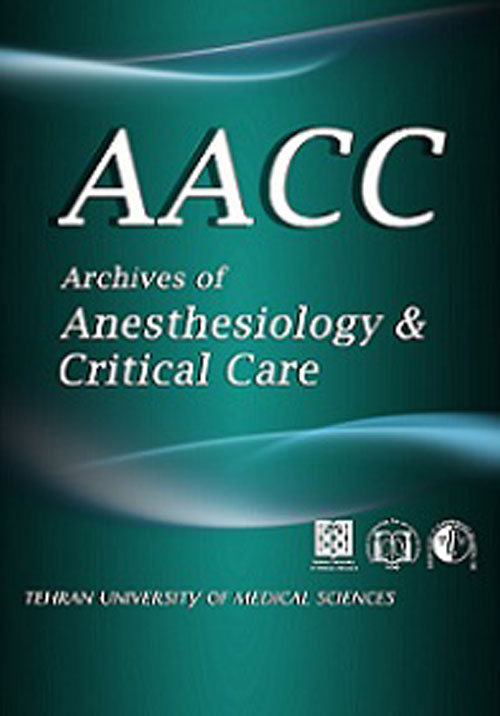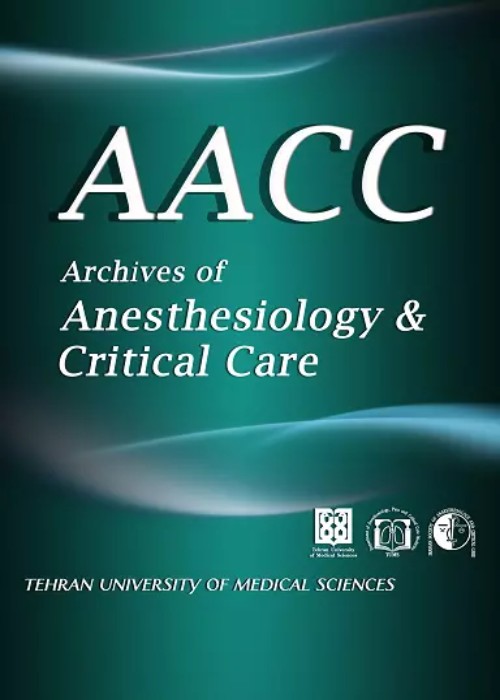فهرست مطالب

Archives of Anesthesiology and Critical Care
Volume:1 Issue: 2, Spring 2015
- تاریخ انتشار: 1394/05/01
- تعداد عناوین: 8
-
-
Pages 37-38Pain is a challenging health dilemma and has gained a great focus in clinico-pathological conditions correlated with post-operative, neuropathic and cancer pain. While perioperative administration of analgesics to mitigate the postoperative pain has been well established in the literature (termed preventive analgesia), preemptive analgesia or effects of any drug (such as anesthetics) prior to operation has been less highlighted [1]. It is important to note that adequate management of the pain either postoperative or neuropathic facilitates functional recovery, decreases financial burden (such as therapeutic costs), diminishes morbidity and improves quality of life of the patients. In this regard, there are emerging lines of evidences indicating that the use of local anesthetics not only potentiate the effects of analgesics but per se, exerts protective effects against the painful conditions [1-2]. Interestingly, while general anesthetics have been reported to render the pain potentiation and inflammation, local anesthetics conversely have potent anti-inflammatory properties, a unique characteristic which plays a critical role in the management of postoperative and neuropathic pain [3-4]. To support the advantageous utilization of local anesthetics in controlling the pain, clinical and preclinical studies have demonstrated the efficacy of these compounds in modulation of painful outcomes of spinal pain, and pain related to hip and knee arthroplasty, foot and ankle surgery, arthroscopic and open shoulder surgery [1-2]. These effects of local anesthetics have been attributed to blocking of the peripheral nerves and prevention of the nerve injury by inhibiting the microglial activation [5-6]. Recently, animal research has demonstrated the functional and structural abnormalities following exposure to general anesthetics in early life. Millions of infants and children experience surgical operations and undergo painful interventions each year. Similarly, epidemiological reports elucidated that exposure to anesthetics in the early child-hood correlated with subsequent neurobehavioral difficulties [7-8]. Collectively, these reports have raised serious concerns that anesthetics may disrupt the normal development of the brain in humans. On the other hand, the fact is that anesthetics also have protective properties against deleterious effects of stress, pain, and ischemia in the immature brain [8]. However, despite the multiple potential benefits of local anesthetics, possible effects of these compounds on the developing brain are elusive.This review calls for epidemiological and preclinical investigations in order to determine if common medications used as local anesthetics may result in the neurobehavioral and neurochemical abnormalities. Considering that using humans for such experiments is practically impossible due to ethical and subjective matters, experimental animal models are widely applied in laboratories. There are questions as to whether exposure to local anesthetics as analgesics in early life may induce behavioral, structural and functional changes in the adulthood and more importantly is the possibility of altered response to analgesics in later life. Although this finding that analgesic effects of local anesthetics have opened new avenues for better management of pain, but this perspective of the possible adverse effects of local anesthetics on developing brain has largely been omitted in the field of research. Apparently, it is important to know that if epidural or systemic administration of local anesthetics is able to induce any harm to the developing brain, their use in the clinics may result in irrecoverable outcomes with huge financial and social burden and negatively affect the children and their families later. Thus, we considered these issues in this review that investigations in this field not only prevent the possible malicious consequences of local anesthetics but at the same time assist the experts in the field in proper utilization of these medications.
-
Pages 39-41BackgroundThe role of premedication with acetaminophen on postoperative conditions in pediatric patients is not well known. We aimed to assess the effects of prophylactic oral versus rectal acetaminophen on postoperative conditions in pediatric adenotonsillectomy patients.MethodsIn a double-blinded randomized clinical trial, 127 children undergoing adenotonsillectomies were randomized to receive either acetaminophen syrup 15 mg/kg (PO group) half an hour before surgery, or acetaminophen suppository 15 mg/kg (PR group) at anesthesia induction. Both groups received dexamethasone 0.1 mg/kg before surgery as an antiemetic and underwent the same general anesthesia management. Postoperative pain was evaluated using the face, legs, activity, cry, consolability (FLACC) scale every 30 min during the first 2 h and every 1 h until 4 h after surgery. Child with a FLACC scale > 3 received rescue medication of acetaminophen syrup 5 mg/kg orally.ResultsThe two groups were not significantly different with respect to patients’ demographics and anesthesia duration. FLACC scales in each time points were similar to each other between the studied groups. Although total postoperative acetaminophen syrup consumption and percentage of nausea or vomiting were lower in the PR group, the differences were not statistically different. The oral feeding starting time was significantly lower in the PR group in comparison with the PO group (p< 0.01).ConclusionWe conclude that prophylactic rectal administration of acetaminophen at anesthesia induction has several beneficial impacts on postoperative conditions in children undergoing adenotonsillectomies.Keywords: acetaminophen, postoperative pain, adenotonsillectomy
-
Pages 42-45BackgroundB Vitamins deficiencies in humans and animals have been known for some time to induce pain and inflammation. These symptoms can be readily alleviated by appropriate administration of Vitamins B. The aim of this study was to evaluate opioids requirements and hemodynamic variables and analgesic effect of B Vitamins and B Vitamins-diclofenac in general anesthesia and Post-anesthesia care unit (PACU).MethodsIn this randomized prospective and double-blinded clinical trial study 105 patients undergoing orthopedic surgery were assessed. Patients were then randomized to receive placebo, B vitamin and diclofenac plus B Vitamins. Preinduction and postinduction hemodynamic parameters and opioid requirement were measured.ResultsSufentanil requirement postoperatively was significantly lower in the DB group (0.12 µg/kg) and B group (0.17 µg/kg) compared with the Placebo group (0.2 µg/kg) (P=0.001). Maximum mean systolic blood pressure related to basal heart rate were increased in DB group 20±6%, B group 30± 17% and P group 35± 9% with significant difference in three groups (P= 0.0001).DiscussionAnalgesic effect of diclofenac plus B Vitamins was better than B Vitamins and required less opioid agents.Keywords: B vitamins, diclofenac, general anesthesia, analgesia
-
Pages 46-49BackgroundCries of the newborn could be due to pain, thirst, hungry and fear from new environment. In our study we evaluated the effect of the sucrose drops on pacifying the children prior to a painful intervention or procedure with regards to the fasting condition of the children.MethodsThis triple blind clinical trial was conducted on 60 otherwise healthy children aged less than 1 year with ASA I, who were candidates for an outpatient surgical procedure after obtaining the parents’ consent. Patients were divided in to two groups, one group received 0.5 ml oral sterile water and the other group 0.5 ml oral sucrose 24%. Heart rate and restlessness were evaluated based on the pediatric anesthesia emergence delirium (PAED) scale score system before and at 1, 3, 5, and 9 minute in both groups.Results60 patients were evaluated in this study, 30 patients received sterile water and 30 patients received sucrose 24%. The sex, mean age and mean weight of the patients showed no significant difference between the two groups. The restlessness score according to the PAED in sucrose group (8.1,7.97,8.8,9.63) is less than in the sterile water group (10.63,10.77,11,10.9) (p‹0.001). Heart rate in sucrose group is less than sterile water group in minute 3 (p=0.006). Parents’ satisfaction in the sucrose group was more than sterile water group (p‹0.001).ConclusionAccording to the findings of this study, we recommend the use of sucrose alone or with other methods (pacifier sucking, mother’s hug) to decrease restlessness in children aged under one year whose restlessness is due to fasting.Keywords: sucrose, sedation, fasting, children
-
Pages 50-54BackgroundIn most operating and recovery rooms, shivering is controlled by the use of humidifiers, warming blankets, and inhalation of humidified heated oxygen. However, pharmacological control is an effective alternative treatment modality. This study was designed to compare the efficacy of tramadol versus meperidine in the treatment of shivering after spinal anesthesia.MethodsIn a double-blind randomized clinical trial, we studied 70 obstetric patients with ASA class I or II who had shivering following spinal anesthesia (SA) with 0.5% bupivacaine. All patients were randomly allocated to one of the two groups receiving tramadol 0.5 mg/kg (group T, n = 35), or meperidine 0.5 mg/kg (group M, n = 35). The onset of cessation of shivering, the efficacy of agents for treatment of shivering, hemodynamic variables, sedation score, pruritus, nausea and vomiting were assessed.ResultsShivering ceased after 2.57±2.26 and 6.24±4.76 minutes in group T and group M respectively (p=0. 03). The differences before and after injection of meperidine for the heart rate, respiratory rate and arterial oxygen saturation were significant (p<0.001). Nausea and vomiting occurred significantly more frequently in the meperidine group compared to the tramadol group (p<0.001).ConclusionTramadol is a more effective agent than meperidine in the treatment of post spinal shivering, with lower early side effects in obstetric patients.Keywords: spinal anesthesia, tramadol, meperidine, shivering
-
Pages 55-58BackgroundObtaining a good sensory and motor block is the goal of performing spinal anesthesia for surgeries. The aim of this study is to compare the effect of trendelenburg position on sensory block level after spinal anesthesia with intrathecal hyperbaric bupivacine.MethodsWe enrolled 80 men, classified as ASA I, scheduled for elective hernia repair under spinal anesthesia. Participants were randomly allocated equally to one of the two groups, horizontal or trendelenburg position. Spinal anesthesia was performed in the sitting position using 15 mg of 0.5% hyperbaric bupivacaine. Then the patients were turned to supine position. In trendelenburg position group, a 20 degree head tilt position was performed for 40 seconds, then the patients were returned to horizontal position and 30 mg ephedrine was administered intramuscularly. Sensory block level and incidence of hypotension were recorded in the two groups.ResultsThere were significant effects of trendelenburg position on sensory block heights during the study period (10.61 ± 0.32segments blocked above the injection point versus 7.24 ± 0.51 in horizontal group). No episodes of severe hypotension were seen among the patients. Six patients in horizontal group experienced intraoperative discomfort or pain, versus no patient in Trendelenburg group. (p=0001).ConclusionA higher level of sensory block can be obtained with performing a short time head down position after intrathecal injection.Keywords: spinal anesthesia, bupivacaine, trendelenburg position, sensory block level
-
Pages 59-62Despite a lot of efforts and investigations worldwide, DNR is still a controversial issue in many countries. In Iran although significant achievements are reached in different fields; end of life care is hardly considered as a scientific necessity. Development and implementation of clear policies for DNR orders is required to prevent futile prolongation of death, psychological stress to the patients and their family, high financial costs and waste of limited resources.Keywords: Decision making, Ethics, Resuscitation orders
-
Pages 63-64The intraoperative care of pheochromocytomas can be difficult and lead to serious complications. We present a case of a 46 year-old female undergoing laparoscopic resection of pheochromocytoma, who was scheduled for surgery with phenoxybenzamine and amlodipin. Under general anesthesia cardiovascular stability was achieved by peritumoral infiltration of lidocaine during resection.Keywords: pheochromocytoma, General anesthesia, local anesthetic infiltration


